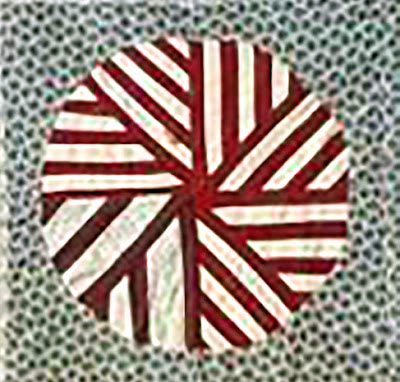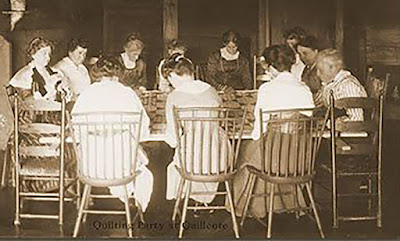Good to find a body of quilts attributed to one quiltmaker.
Here are five early-20th-century quilts attributed to Mildred Beene Lee (1847-1939.) Millie lived a long life, about half of it in Tennessee and the last 40 years in Alabama, where these quilts were stitched. What can we figure out about southern style in Millie's five quilts?
My favorite is the baseball quilt at the top---looks quite improvisational, vivid colors, clothing scraps--- The kind of thing we might expect from Alabama, famous for its Gees Bend improvisational work by African American quiltmakers.
Unknown Gees Bend quiltmaker
Currier Museum of Art
Millie Lee's version perhaps 25 years earlier.
(I've done some color correction and squaring up of these old slides
from the Tennessee project, which recorded Millie's quilts.)
One thing learned from studying Southern-style quilts is that you cannot tell a person's ethnic origins by her quilt style whether improvisational or impeccable needlework. Although you can sometimes be very accurate in guessing which side of the Mason/Dixon line she called home.
Mildred Angeline Beene Lee
from her FindaGrave page.
She was from South Pittsburg, Tennessee.
Mildred and husband Elisha Lightfoot Lee (1840-1936) moved from their Tennessee home to Bridgeport, Alabama about 1895, perhaps so the doctor could work at the Vanderbilt Training School there.

Another misconception about Southern quilts is that they are make-do bedding, often described as made of clothing scraps because "That's all she had," implying that these quilts come from poor homes. But the Lees were not financially disadvantaged, shall we say.
1923 social note from the Nashville newspaper.
Millie Lee often made the local news when she visited old friends.
About 1900
She often went home to South Pittsburg.
Dr. E. Lightfoot Lee was descended from that Lee family of Virginia. He was a physician with a degree from Vanderbilt University (then the University of Nashville) who retired from his Tennessee practice in 1893 in his fifties and moved to Alabama just south of the Tennessee line. They may have chosen Bridgeport because there was an affiliated school there the Vanderbilt Training Institute. He then devoted his time to science, studying geology and botany, where he made a name for himself as an expert in ferns. After his death his herbarium of fern specimens was given to Emory University in Atlanta.
Well, we digress (although herbariums are a special interest this year
with the Block of the Month on my CivilWarQuilts blog.)
The point (oh, I remember) is that you cannot rely on quilt style to tell you much about person's race, ethnic background or income level. Mildred Lee's 5 quilts speak much more about what was fashionable along the Tennessee/Alabama state line in the early 20th century than about her life as a woman of society.
Well, they also might tell us that she had 6 grown children (a 4-year-old died in 1887) and by 1910 or so the first of many grandchildren.
Eldest daughter Frances Lee Turner was a painter. Her oil painting of Georgia's Bulloch Hall is in the Smithsonian's American Art Museum. Frances also had 7 children born in the early 20th century.
Crib quilt brought in for documentation by
Millie's Tennessee grandchild.
BlockBase #1504
The quilts tell us something about the commercial pattern business that created standard style in the 20th century. The baseball quilt was a pattern published by the Ladies Art Company and several other periodicals and pattern houses in various colorways. Their catalog of hundreds of patterns was an important influence on how 20th century quilts looked north and south. Did anyone in Alabama call it Boston Puzzle?
Mildred's Findagrave page:










































BPcO+M3tKw~~60_57.jpg)












